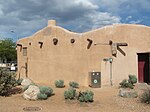University of New Mexico Arboretum
The University of New Mexico Arboretum is an arboretum extending throughout the University of New Mexico campus in Albuquerque, New Mexico. The arboretum contains some 320 species of woody plants, including Albizia julibrissin, Buxus microphylla japonica, Campsis radicans, Cercis canadensis, Chilopsis linearis, Cotoneaster lacteus, Cupressus arizonica, Forestiera neomexicana, Fraxinus pennsylvanica, Fraxinus velutina, Ginkgo biloba, Gleditsia triacanthos inermis, Hedera helix, Juniperus communis, Juniperus sabina 'Broadmoor', Koelreuteria paniculata, Morus alba 'Pendula', Nandina domestica, Photinia serrulata, Pinus mugo, Pinus nigra, Pinus ponderosa, Pinus sylvestris, Platanus × hispanica, Poa pratensis, Populus canadensis 'Eugenii', Populus tremuloides, Rhaphiolepis indica, Salix babylonica, Ulmus pumila, Vitex agnus-castus.
Excerpt from the Wikipedia article University of New Mexico Arboretum (License: CC BY-SA 3.0, Authors).University of New Mexico Arboretum
Vassar Drive Northeast, Albuquerque Nob Hill
Geographical coordinates (GPS) Address Nearby Places Show on map
Geographical coordinates (GPS)
| Latitude | Longitude |
|---|---|
| N 35.085 ° | E -106.62194444444 ° |
Address
University of New Mexico (UNM)
Vassar Drive Northeast
87131 Albuquerque, Nob Hill
New Mexico, United States
Open on Google Maps








